Revealed: what our data says about the UK’s mental health
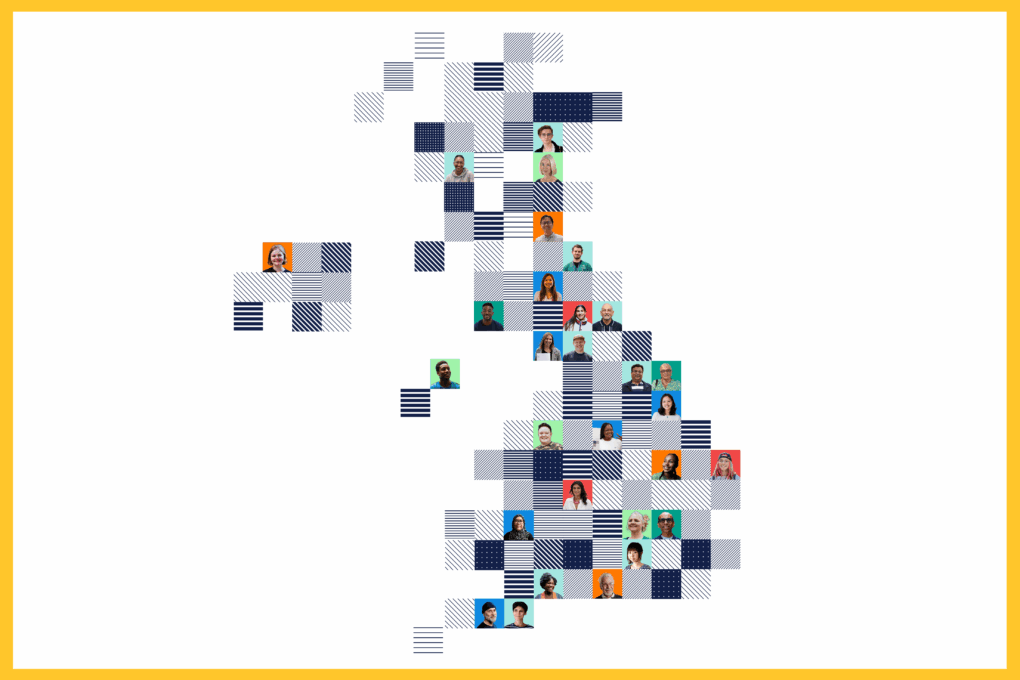
Thanks to the continued support of the UK public, Our Future Health is now the world’s largest data set for mental health research.
Since October 2022, millions of people from across the UK have joined our programme to help health researchers prevent, detect, and treat diseases.
As part of the joining process, people are asked to complete our health and lifestyle questionnaire, which includes questions about mental wellbeing.
In total, there are 16 to 18 questions in the questionnaire that focus on mental health (the number varies depending on how certain questions are answered). These questions are designed to assess whether someone is currently experiencing the symptoms of depression and/or anxiety.
By analysing the answers, we can shine new light on the UK’s mental health.
The big picture
Our analysis, undertaken in May 2025, included 1,590,982 questionnaires. We estimated how common mental health diagnoses and recent symptoms of depression and anxiety were, among people who responded to questions on those topics. These estimates were adjusted for age and sex, where applicable.
According to the data, 1 in 6 people taking part in Our Future Health self-report that they have been diagnosed with depression at some point in their lifetime. 1 in 7 say they have been diagnosed with anxiety at some point in their lifetime.
Women were almost twice as likely as men to self-report that they’ve had a depression diagnosis (20.5% vs 12.3%), and almost twice as likely to report an anxiety diagnosis (18.2% vs 10.0%).
The answers also reveal that 1 in 4 men and 1 in 3 women reported experiencing symptoms of depression in the 2 weeks before they filled out their questionnaire. We know this because the questionnaire includes a set of questions known as PHQ-9, which is designed to assess people for recent symptoms of depression.
PHQ-9 is widely used by doctors to identify whether someone is experiencing symptoms of depression – and how severe their symptoms are. Severity ranges from ‘minimal depression’ to ‘severe depression’.
1 in 10 people were found to be experiencing symptoms that were ‘moderate’ or ‘severe’.
Our questionnaire also uses a set of questions known as GAD-7. These are designed to identify whether someone has experienced symptoms of anxiety in the last two weeks.
According to our data, 1 in 4 men and 1 in 3 women from the cohort report experiencing symptoms of anxiety.
The age effect
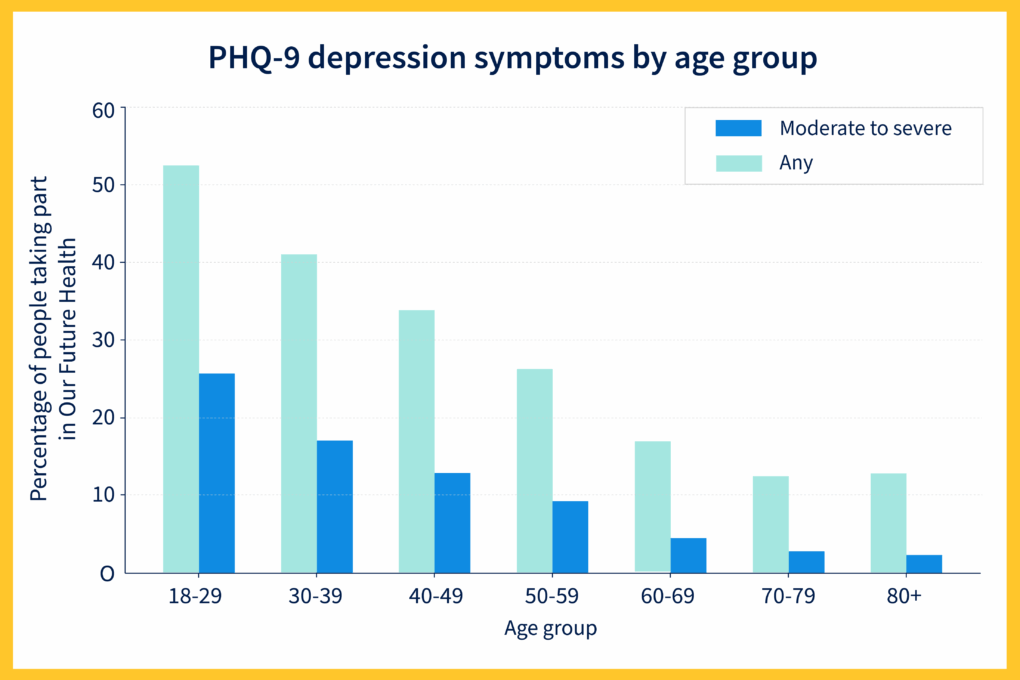
Younger people were more likely than older people to report recent symptoms of anxiety and depression.
For example, people aged 18-29 years old were over 4 times more likely to report experiencing any symptoms of depression in the last 2 weeks than people over 80 years of age (52.3% vs 12.80%).
If you narrow the view to people with moderate to severe symptoms, you find that the younger age group is 10 times more likely to experience symptoms than the older age group (25.8% to 2.4%).
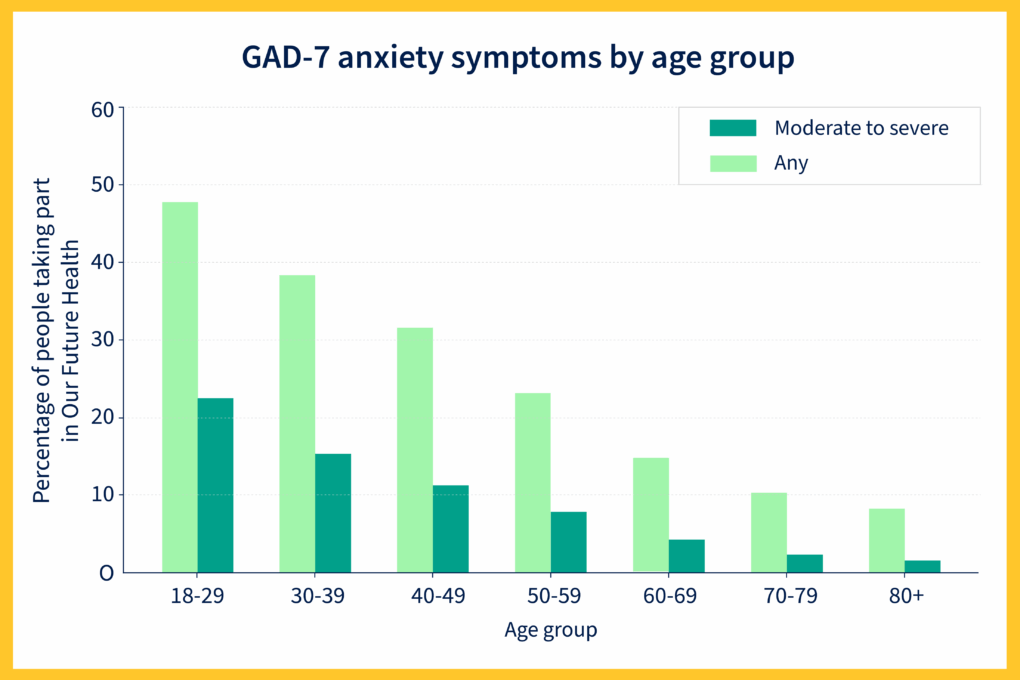
A similar trend can be seen in anxiety. With every increase in age group, the rates of anxiety symptoms decrease. This is true across all severities of symptoms (see the table at the end of this article).
The role of work and income
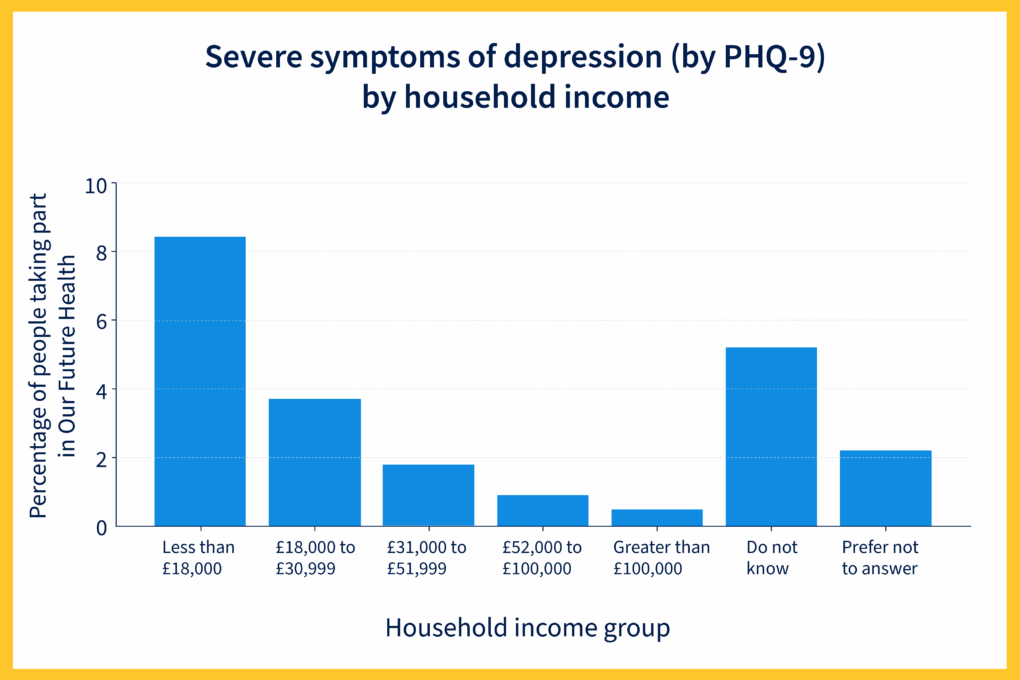
Our data suggests that people with lower household incomes were more likely than those with higher household incomes to report experiencing symptoms of depression or anxiety.
People taking part in Our Future Health with a household income less than £18,000 were over 16 times more likely to report experiencing symptoms of severe depression in the last 2 weeks than those with an income above £100,000 (8.4% vs 0.5%).
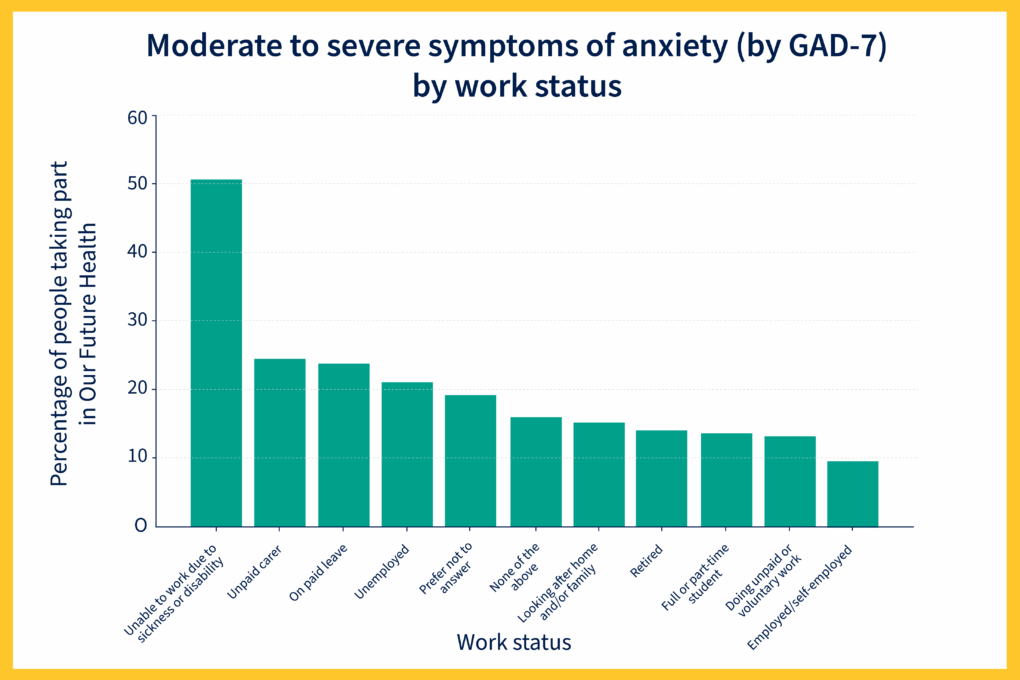
Symptoms of anxiety were highest among people unable to work due to sickness or disability, being an unpaid carer, on paid leave, or unemployed.
The GAD-7 questions revealed that 50.7% of people who are unable to work because of sickness or disability showed moderate or severe symptoms of anxiety in the two weeks before answering their questionnaire. This compared with 24.5% of unpaid carers and 21.0% of unemployed people.
9.6% of people in paid employment or self-employed experienced moderate or severe symptoms of anxiety according to their GAD-7 score.
‘An insight into the nation’s mental health’
Dr Ros Blackwood is the director of population health insights at Our Future Health. “The analysis we’re revealing today gives us insights into how the prevalence of mental health issues may differ across demographics of the UK population,” says Ros.
“It’s hard to overstate the scale of our resource for mental health research. Almost 2 million adults in the UK have now filled in our health and lifestyle questionnaire, helping to create the world’s largest resource for mental health data. And more people are joining them every day.
“Taken together, their questionnaire answers paint an incredibly detailed picture of the nation’s mental health. Researchers can apply to study the information, to spot new patterns and make new discoveries in how we prevent, detect and treat mental health diseases.
“This week, we’ve seen the publication of the first peer-reviewed scientific paper using our dataset. The study, which was published in BMJ Mental Health, found that people living with chronic inflammatory conditions may have almost double the risk of mental health issues such as anxiety, depression and bipolar disorder.
“We’re thrilled to see the first paper out there generating impact – and we’re looking forward to many more in the future.”
More about Our Future Health’s data for researchers
Earlier this month, we released new data into our trusted research environment (TRE) – the secure computing environment where researchers can analyse de-identified data.
As of 10 June 2025, there are 1,781,891 sets of answers to our health and lifestyle questionnaire. The TRE also contains genetic data for hundreds of thousands of volunteers.
More about Our Future Health and mental health research
You can read our Spotlight article to find out more about how Our Future Health can help researchers get ahead of the mental health curve.
Health researchers are already studying our data to learn more about mental health diseases. Daniel Smith, who co-authored the first paper, previously called our resource “uniquely powerful”. Professor Cathryn Lewis said it is a “goldmine for studies on depression”.
Our Future Health is partnered with MQ, a charity that funds scientific research into mental health. To find out more about their work, visit mqmentalhealth.org
Mental health data tables
The following tables display data from our analysis of 1,590,982 questionnaires. The data was used to create the graphs that you can see in this article.
PHQ-9 depression symptoms by sex
| Sex | No depression | Mild depression | Moderate depression | Moderately severe depression | Severe depression |
| Female | 65.0% | 20.4% | 8.3% | 3.9% | 2.4% |
| Male | 72.8% | 16.9% | 5.8% | 2.7% | 1.7% |
GAD-7 anxiety symptoms by sex
| Sex | No anxiety | Mild anxiety | Moderate anxiety | Severe anxiety |
| Female | 66.8% | 19.9% | 7.5% | 5.9% |
| Male | 76.4% | 15.0% | 5.0% | 3.6% |
PHQ-9 depression symptoms by age group
| Age group | No depression | Mild depression | Moderate depression | Moderately severe depression | Severe depression |
| 18-29 | 47.7% | 26.4% | 13.9% | 7.3% | 4.6% |
| 30-39 | 58.9% | 24.1% | 9.7% | 4.6% | 2.7% |
| 40-49 | 66.2% | 20.9% | 7.5% | 3.2% | 2.1% |
| 50-59 | 73.7% | 17.0% | 5.4% | 2.3% | 1.6% |
| 60-69 | 83.2% | 11.9% | 3.0% | 1.2% | 0.7% |
| 70-79 | 87.5% | 9.8% | 2.0% | 0.6% | 0.2% |
| 80+ | 87.2% | 10.4% | 1.8% | 0.5% | 0.1% |
GAD-7 anxiety symptoms by age group
| Age group | No anxiety | Mild anxiety | Moderate anxiety | Severe anxiety |
| 18-29 | 52.0% | 25.4% | 12.6% | 9.9% |
| 30-39 | 61.4% | 23.2% | 8.7% | 6.7% |
| 40-49 | 68.3% | 20.3% | 6.4% | 5.0% |
| 50-59 | 76.8% | 15.4% | 4.5% | 3.4% |
| 60-69 | 85.0% | 10.7% | 2.6% | 1.6% |
| 70-79 | 89.6% | 7.9% | 1.6% | 0.7% |
| 80+ | 91.2% | 6.6% | 1.2% | 0.5% |
PHQ-9 depression symptoms by household income
| Household income | No depression | Mild depression | Moderate depression | Moderately severe depression | Severe depression |
| Less than £18,000 | 50.2% | 21.0% | 11.9% | 8.5% | 8.4% |
| £18,000 to £30,999 | 60.6% | 20.6% | 9.8% | 5.3% | 3.7% |
| £31,000 to £51,999 | 67.1% | 20.0% | 7.8% | 3.4% | 1.8% |
| £52,000 to £100,000 | 73.3% | 17.9% | 5.8% | 2.1% | 0.9% |
| Greater than £100,000 | 78.6% | 15.4% | 4.2% | 1.3% | 0.5% |
| Do not know | 58.7% | 20.3% | 10.0% | 5.7% | 5.2% |
| Prefer not to answer | 71.4% | 17.0% | 6.5% | 3.0% | 2.2% |
GAD-7 anxiety symptoms by work status
| Work status | No anxiety | Mild anxiety | Moderate anxiety | Severe anxiety |
| Employed/self-employed | 72.8% | 17.6% | 5.8% | 3.8% |
| Retired | 73.4% | 13.2% | 7.1% | 6.3% |
| Looking after home and/or family | 65.7% | 19.2% | 8.0% | 7.1% |
| Unable to work due to sickness or disability | 27.7% | 21.6% | 18.6% | 32.1% |
| On paid leave | 53.2% | 23.0% | 10.4% | 13.4% |
| Doing unpaid or voluntary work | 68.7% | 18.1% | 7.8% | 5.4% |
| Full or part-time student | 68.1% | 18.6% | 7.9% | 5.4% |
| Unpaid carer | 53.1% | 22.4% | 12.1% | 12.4% |
| Unemployed | 57.9% | 21.1% | 10.8% | 10.2% |
| None of the above | 65.9% | 18.5% | 7.9% | 7.7% |
| Prefer not to answer | 62.1% | 18.8% | 8.0% | 11.1% |

Let’s prevent disease together
By volunteering for Our Future Health, you can help health researchers discover new ways to prevent, detect and treat common conditions such as diabetes, cancer, heart disease, stroke and Alzheimer’s.